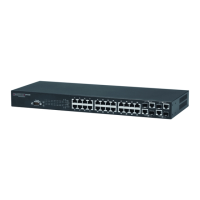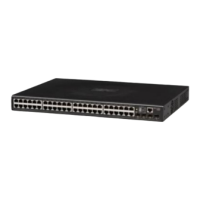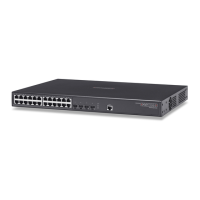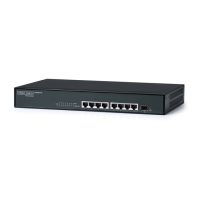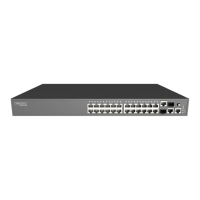C
HAPTER
16
| IP Configuration
Setting the Switch’s IP Address (IP Version 6)
– 417 –
CONFIGURING IPV6
INTERFACE SETTINGS
Use the IP > IPv6 Configuration (Configure Interface) page to configure
general IPv6 settings for the selected VLAN, including auto-configuration of
a global unicast interface address, explicit configuration of a link local
interface address, the MTU size, and neighbor discovery protocol settings
for duplicate address detection and the neighbor solicitation interval.
CLI REFERENCES
◆ "IPv6 Interface" on page 925
◆ "DHCP Client" on page 911
COMMAND USAGE
◆ The switch must always be configured with a link-local address. The
switch’s address auto-configuration function will automatically create a
link-local address, as well as an IPv6 global address if router
advertisements are detected on the local interface.
◆ The option to explicitly enable IPv6 will also create a link-local address,
but will not generate a global IPv6 address if auto-configuration is not
enabled. In this case, you must manually configure an address (see
"Configuring an IPv6 Address" on page 420).
◆ IPv6 Neighbor Discovery Protocol supersedes IPv4 Address Resolution
Protocol in IPv6 networks. IPv6 nodes on the same network segment
use Neighbor Discovery to discover each other's presence, to determine
each other's link-layer addresses, to find routers and to maintain
reachability information about the paths to active neighbors. The key
parameters used to facilitate this process are the number of attempts
made to verify whether or not a duplicate address exists on the same
network segment, and the interval between neighbor solicitations used
to verify reachability information.
PARAMETERS
These parameters are displayed:
◆ VLAN – ID of a configured VLAN which is to be used for management
access. By default, all ports on the switch are members of VLAN 1.
However, the management station can be attached to a port belonging
to any VLAN, as long as that VLAN has been assigned an IP address.
(Range: 1-4093)
◆ Address Autoconfig – Enables stateless autoconfiguration of IPv6
addresses on an interface and enables IPv6 functionality on that
interface. The network portion of the address is based on prefixes
received in IPv6 router advertisement messages, and the host portion
is automatically generated using the modified EUI-64 form of the
interface identifier (i.e., the switch’s MAC address).
■
If the router advertisements have the “other stateful configuration”
flag set, the switch will attempt to acquire other non-address
configuration information (such as a default gateway).
■
If auto-configuration is not selected, then an address must be
manually configured using the Add Interface page described below.

